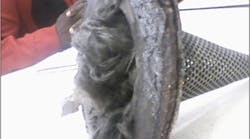Ever seen an X-ray of an unfortunate patient whose physician inadvertently left behind a pair of surgical scissors or some gauze before the patient was stitched up? Everyone assumes the surgery has gone well until the patient begins complaining of site-specific pain.
In the industrial world, condition-based asset monitoring allows companies to identify problems like these before they cause a catastrophe – a medical emergency, so to speak. That’s the situation in which a large American petrochemical company found itself with one of its large pumps: A left-behind tool threatened to derail operations, but thanks to early detection of the problem, the company saved an estimated half a million dollars in downtime-related expenses.
The oil company opted to have a series of vibration- and temperature-tracking sensors installed on one of its critical pumps to keep better tabs on the pump’s health. The pump’s supplier, Flowserve, implemented an active performance monitoring system built on the PI System, an open data infrastructure developed by OSIsoft. Flowserve’s IPS Wireless system collects data from an end user’s assets and feeds that data through the PI System. Then Flowserve, as the OEM, applies its product expertise to provide end users with detailed asset performance analysis and actionable insights.
During setup, engineers from Flowserve and the oil company collaborated on development of vibration alarms for the pump. With an eye toward preventing alarm fatigue, the engineering team sought to establish meaningful alarm thresholds so that any alarm that sounded would signal a definite problem requiring attention. The collected vibration data was used to set baselines for normal vibration conditions, and alarm triggers were set based on rolling averages (a last-four-points rolling average and a one-hour rolling average) for vibration to account for temporary and generally harmless vibration spikes that are commonly seen at certain process points.
“If you have a bunch of false alarms, then it becomes useless,” says Greg Herr, general manager of monitoring and reliability for Flowserve, who assisted in getting the pump condition-monitoring system off the ground. “People aren’t going to trust it. It’s actually worse than having nothing.”
When a major vibration change occurred during a routine unit startup, engineers knew something was up. “We noticed a step change up in the vibration signature right after unit startup compared to the baseline set prior to the unit outage,” Herr says. “That told them right away that something was not right, allowing the engineers to troubleshoot, diagnose, and safely shut the pump down.”
Data suggested that the pump was operating under starved suction conditions. Sure enough, once the pump was shut down and the suction strainer was pulled, the source of the problem was revealed: A welder’s insulation blanket, used to protect against weld splatter and for eye protection, had somehow fallen into the pipe during the previous restart and been swept into the strainer, where it was clogging the pump’s suction nozzle.
The total time to pull the suction strainer, remove the blanket, and get the pump back in service was less than an hour, though that process alone cost approximately $50,000 in production losses. Still, had the vibration change gone undetected, losses would have been much larger. The oil company estimated based on similar events that had occurred that continued operation of the pump under starved suction conditions would have eventually resulted in a failure requiring at least seven days of downtime and parts replacement/reassembly costs totaling around $630,000.
“If you let a problem like this run for a period of time, you can end up with major equipment damage,” Herr says. “By catching it earlier, you save the cost of equipment repair and extended unplanned downtime for the entire unit.”
Condition monitoring doesn’t necessarily mean having to have a bunch of data experts on your in-house team or having to collect and store so much data that you’re drowning in metrics, notes Josh Lyon, Flowserve senior manager of marketing and technology. As a plant’s assets become better connected via the Industrial Internet and product vendors turn their attention to offering after-market monitoring services, expertise about operation of a particular piece of equipment doesn’t have to rely exclusively with the plant’s in-house staff.
Flowserve offers customers different escalation options with respect to vibration alarms, for example. Some companies prefer to keep escalation in house, with managers receiving an automatic alert if a specified amount of time passes without action by a technician to address an alarm. Other companies have alerts sent directly to Flowserve because they don’t want to receive notifications – just answers.
Critical to enabling the condition-monitoring platform for Flowserve was the partnership with OSIsoft, which is working with Flowserve and other original equipment manufacturers to expand after-market service offerings as vendors shift from selling physical products alone to selling products, performance analysis, and troubleshooting assistance. And as end users expand their partnerships with infrastructure experts, there’s opportunity for unprecedented collaboration and validation among data software providers, OEMs, and end users. That’s why, with respect to asset/product performance data on either the OEM side or the end-user side, “You have to get over the phobia of opening some of that data up,” says Enrique Herrera, market principal at OSIsoft.
Says Flowserve’s Lyon: “We’re getting to that point with the Industrial Internet and Big Data analytics of (customers) saying, ‘I don’t want to know what’s going on with 40 pieces of equipment that are running well. (They say) ‘I want to walk right past them, and I want my people to concentrate on the one or four pieces of equipment that aren’t running well ... I want to devote my resources and energy and time on the ones that aren’t performing well so I can prevent them from failing.”
Herr echoes the comment. “You need to be able to sift through (the data) and identify the critical things that are happening,” he says. “The ability to forecast potential failures ... that’s where the industry’s going. The loss of production can be astronomical in terms of cost.”
[sidebar id="5"]

